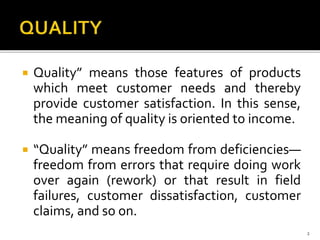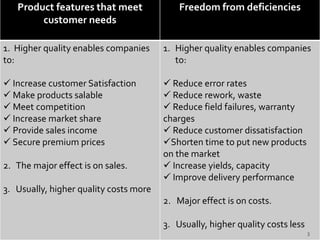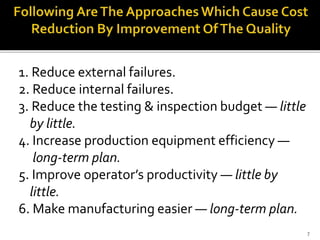Quality improvement and cost reduction
- 1. 1 AISSMS COLLEGE OF PHARMACY, PUNE-01 Prepared by SHIVANI KAILAS CHAUDHARI M. Pharmacy (Dept. of Quality Assurance)
- 2. ’éĪ QualityŌĆØ means those features of products which meet customer needs and thereby provide customer satisfaction. In this sense, the meaning of quality is oriented to income. ’éĪ ŌĆ£QualityŌĆØ means freedom from deficienciesŌĆö freedom from errors that require doing work over again (rework) or that result in field failures, customer dissatisfaction, customer claims, and so on. 2
- 3. Product features that meet customer needs Freedom from deficiencies 1. Higher quality enables companies to: ’ā╝ Increase customer Satisfaction ’ā╝ Make products salable ’ā╝ Meet competition ’ā╝ Increase market share ’ā╝ Provide sales income ’ā╝ Secure premium prices 2. The major effect is on sales. 3. Usually, higher quality costs more 1. Higher quality enables companies to: ’ā╝ Reduce error rates ’ā╝ Reduce rework, waste ’ā╝ Reduce field failures, warranty charges ’ā╝ Reduce customer dissatisfaction ’ā╝Shorten time to put new products on the market ’ā╝ Increase yields, capacity ’ā╝ Improve delivery performance 2. Major effect is on costs. 3. Usually, higher quality costs less 3
- 4. 4
- 5. SPORADIC PROBLEM CHRONIC PROBLEM Sporadic means now and then chronic means all the time A sporadic problem is a sudden, adverse change in the status quo, which requires remedy by restoring the status quo. A chronic problem is a long-standing adverse situation, which requires remedy by changing the status quo. Sporadic problems are dramatic and must receive immediate attention. Chronic problems are not dramatic because they occur for a long time & are often difficult to solve, and are accepted as inevitable sporadic problems it means taking corrective action on periodic problems For chronic problems, it means achieving better & better levels of performance each year, Sporadic problems are attacked by the control process. Chronic problems use the improvement process. 5
- 6. Need for quality improvement and cost reduction Customer Satisfaction Reduction in the cost of poor quality Reduction in the chronic waste Action on late deliveries Reducing variation 6
- 7. 1. Reduce external failures. 2. Reduce internal failures. 3. Reduce the testing & inspection budget ŌĆö little by little. 4. Increase production equipment efficiency ŌĆö long-term plan. 5. Improve operatorŌĆÖs productivity ŌĆö little by little. 6. Make manufacturing easier ŌĆö long-term plan. 7
- 8. ’éĪ Joseph M. Juran, Frank M. Gryna, et al: ŌĆ£JuranŌĆÖs Quality Planning & Analysis for Enterprise QualityŌĆØ, 5th Edition, McGraw-hill Publication, Pg No: 29, 33- 35, 59, 64-65, 67 ’éĪ Joseph M. Juran, A. Blanton Godfrey: ŌĆ£ JuranŌĆÖs Quality HandbookŌĆØ, 5th Edition, Mcgraw-hill Publication, Pg No: 2.1-2.2, 2.5-2.7, 3.2-3.3, 4.2, 4.5, 5.3, 8.14- 8.16 8








